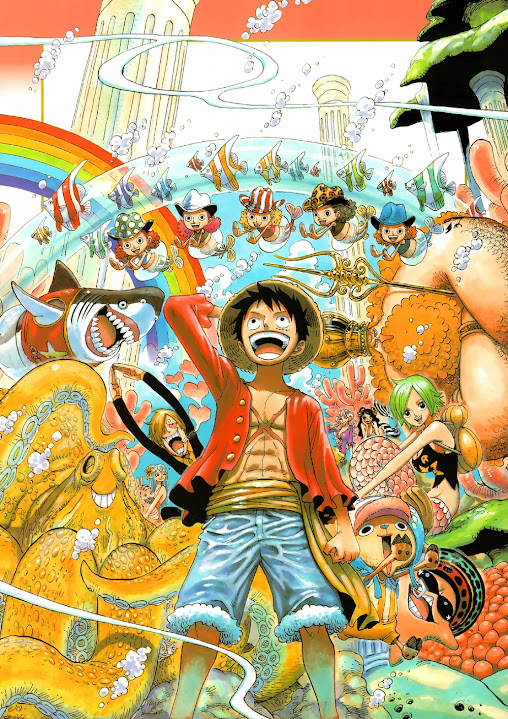One Piece- Fish-Man Island Saga
The Fish-Man Island Saga in One Piece stands as a pivotal moment in the series, bridging the first half of the Grand Line adventures with the intense New World challenges ahead. It’s more than just an underwater adventure; it’s a saga rich with emotional depth, world-building, and powerful themes of discrimination, unity, and ambition.
Return to Sabaody Arc: Reunions and New Beginnings
The saga begins with the long-awaited reunion of the Straw Hat Pirates after a two-year time skip. Each crew member has undergone rigorous training, refining their abilities to face the challenges of the New World.
The arc highlights their growth as individuals and as a
team. From Luffy’s mastery of Haki to Franky’s technological upgrades, the
Straw Hats are stronger and more united than ever. The return to Sabaody is
also marked by chaos as imposters try to pose as the Straw Hats, only to be
hilariously unmasked.
Key Moments:
- Luffy’s effortless defeat of a Pacifista, showcasing his newfound strength.
- The Straw Hats escaping Sabaody with the help of the coated ship, the Thousand Sunny, as they finally head toward Fish-Man Island.
Fish-Man Island Arc: Exploring a World Under the Sea
The Fish-Man Island Arc introduces a breathtaking underwater kingdom filled with vibrant characters and deep lore. Located 10,000 meters beneath the ocean, Fish-Man Island is home to mermaids, fish-men, and diverse aquatic species.
The Setting
Fish-Man Island is visually stunning, with its coral
architecture, glowing underwater lights, and bustling Merfolk Plaza. Yet,
beneath its beauty lies a society plagued by tension between humans and
fish-men, a recurring theme throughout the arc.
The Conflict
The arc centers on the rise of the New Fish-Man Pirates, led
by Hody Jones, who seeks to overthrow King Neptune and plunge Fish-Man Island
into chaos. Hody's hatred for humans, fueled by Arlong's ideology, adds a
personal connection to Nami, who still bears scars from her traumatic past in
the Arlong Park Arc.
Luffy and the Straw Hats become embroiled in the conflict,
fighting to protect Fish-Man Island and uphold their promise to Jimbei.
Themes
This arc explores themes of racism and forgiveness, focusing
on the strained relations between humans and fish-men. Through characters like
Queen Otohime and Fisher Tiger, we see two different approaches to bridging the
divide—peaceful activism and rebellion. The arc also emphasizes the importance
of moving past hatred and striving for coexistence.
Key Highlights and Battles
- Noah’s Descent: Luffy’s desperate attempt to stop the massive ship Noah from crashing into Fish-Man Island highlights his determination to protect all lives, regardless of species.
- The Straw Hats’ Growth: Each crew member gets a chance to showcase their new abilities in battles against the New Fish-Man Pirates, proving their training has paid off.
- Hody Jones vs. Luffy: The climactic battle between Luffy and Hody underscores the difference between inherited hatred and self-earned strength. Luffy's Gear Fourth and Haki mastery shine here.
- Big Mom’s Introduction: The arc ends with a confrontation between Luffy and Big Mom, setting the stage for the Whole Cake Island saga. Luffy boldly declares war on the Yonko, signaling his rise as a major player in the New World.
Jimbei and the Promise
Jimbei, the honorable fish-man who played a key role in
the Impel Down and Marineford arcs, takes the spotlight
again. His bond with Luffy strengthens, and he officially invites Jimbei to
join the crew—though Jimbei asks to postpone his acceptance.
The Bigger Picture
The Fish-Man Island Saga isn’t just a transitional
saga; it’s a narrative tapestry that weaves together past arcs and sets up
future conflicts. It revisits the ideals of Fisher Tiger and Queen Otohime,
introduces the concept of ancient weapons with Shirahoshi as Poseidon, and
foreshadows the upcoming challenges in the New World.
Why Fish-Man Island Saga Matters
- World-Building: Fish-Man Island expands the One Piece universe, providing rich cultural and historical context.
- Character Development: The arc showcases the Straw Hats' post-time-skip growth and Luffy’s emergence as a true leader.
- Themes of Equality: It tackles serious social issues, making it one of the most emotionally impactful arcs in the series.
The Fish-Man Island Saga is a masterful blend of
action, emotion, and storytelling, paving the way for the Straw Hats’ grander
adventures in the New World. It’s a reminder of One Piece’s ability
to blend fantastical adventures with meaningful life lessons, leaving fans
excited for what’s to come.
What did you love most about this saga? Share your thoughts
below! 🏴☠️

Comments
Post a Comment